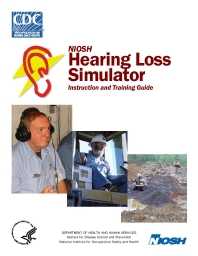Mining Publication: NIOSH Hearing Loss Simulator Instruction and Training Guide
Original creation date: March 2008
The NIOSH Hearing Loss Simulator is a software training and communication tool for promoting hearing loss prevention. It allows a user or trainer to demonstrate the effects of noise exposure on hearing without experiencing an actual noise-induced hearing loss. Estimates of the effects of different levels of noise exposure are based on the American National Standard Determination of Occupational Noise Exposure and Estimation of Noise-Induced Hearing Impairment, otherwise known as ANSI S3.44. This standard specifies the predicted hearing loss for noise-exposed populations of individuals based on risk factors that include gender, age, sound levels (in A-weighted decibels or dBA), and years of exposure. Algorithms specified in the standard were derived from empirical studies of populations that had no exposure to loud noise and other populations that had experienced various levels and durations of noise exposure. This manual explains the major objectives that can be addressed with the simulator and training scenarios that can be applied to real-life, real worker scenarios. The majority of this guide explains the simulator's functions in detail. Simulator users are encouraged to read this manual while learning how to run the software.
Authors: RF Randolph, DC Reinke, RL Unger
NIOSH/USBM Numbered Publication - March 2008
NIOSHTIC2 Number: 20033424
Pittsburgh, PA: U.S. Department of Health and Human Services, Public Health Service, Centers for Disease Control and Prevention, National Institute for Occupational Safety and Health, DHHS (NIOSH) Publication No. 2008-119, 2008 Mar; :1-9
See Also
- Development and Evaluation of a Urethane Jacketed Tail Roller for Continuous Mining Machines
- Evaluation and Development of Hearing Loss Interventions
- Hearing Loss Prevention in Mining - 2005
- Noise and Hearing Protection: Development of Two Training Exercises for Drillers
- Noise Source Identification on a Continuous Mining Machine
- Noise Source Identification on a Horizontal Vibrating Screen
- Snapshot of Noise and Worker Exposures in Sand and Gravel Operations
- Water Well Safety Bits: Health And Safety Information For The Water Well Industry
- What Does a Hearing Loss Sound Like?
- Working in Noise with a Hearing Loss: Perceptions from Workers, Supervisors, and Hearing Conservation Program Managers
- Content source: National Institute for Occupational Safety and Health, Mining Program


 ShareCompartir
ShareCompartir
